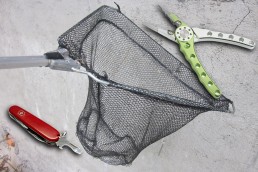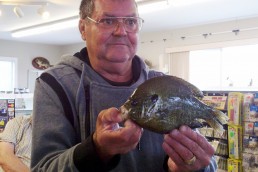Favorite Fishing Accessories: Boat Edition
SHARE THIS POST
Gear Review
We reserve the word ‘review’ for true reviews.
Our stamp of approval can only be earned
one way: by making a superior product.
No favors handed out.
Glowing praise not for sale.
Go shopping with confidence, because…
If we say it works, it works!
In addition to rods, reels, line and lures, an endless collection of other stuff directly related to fishing success cries out to you from every aisle of the local tackle shop.
Of all those possibilities, which ones should you make room for in the boat?
We offer this list as one way to go, tailored to freshwater fishing in the Midwest.
We’re not considering things like life jackets, fire extinguishers, first-aid kits and lights, but those will make fine fodder for future reviews. This time, it’s all about fishing-specific accessories.
» Fishing tools
You gotta be able to rig lures, cut line, replace line, fix reels, replace hooks, and more while you’re out on the water. I keep fishing-specific tools in a clear plastic container near my driver’s seat in the back of the boat.
Your needs could vary, but here are key items that get used a lot.
- Regular clippers, for cutting monofilament and fluorocarbon line.
- “Superline scissors” for cutting braided and other types of no-stretch lines.
- Hook-sharpening tools (various sizes, for different size hooks).
- Pocket knife.
- Needle-nose pliers.
- Split-ring pliers. (Pack replacement split-rings of various sizes, and replacement hooks in the most common sizes for your lures.)
- Backlash-clearing “pic” tool. A current version sells for about $5, the Bass Pro Baitcast Pic. (See also: sidebar on the “thumb pressure trick” for clearing backlashes.)
- Jig “eyebuster” for clearing paint from the eyelets of jigs.
- Crankbait tuning tool. A long time ago, I got an awesome tuning tool from Bucher Tackle that was apparently designed by a guy who used to work for Harley Davidson. At least, that’s the story I heard. If you don’t have one, try the Bass Pro Tuning Tool Key for $5.50. Pliers work, but it’s more fun to use a tuning tool.
- Reel oil. You can at least apply a few drops into levelwind gears and any other squeaky wheels that pop up in your arsenal of reels.
- Sunglasses cleaning cloth or microfiber cleaning tool. You can’t fish well if your sunglasses are dirty or all fogged up.
» Fish-handling stuff
For a smooth operation, I keep a set of fish-handling tools at both ends of the boat: glove, Hookout, mouth spreader in two sizes.
Fillet glove
They double as stars for their namesake function of gripping fish at the fillet table, but “fillet gloves” are also awesome for hand-landing fish.
Pertains to pike as much as any species, but walleyes can be picked up, too, along with bass that have multiple treble hooks right where your thumb would usually go.
The key is that your hands don’t slip, so you can pick up a fish without squeezing hard. Then, you can maintain that hold as you unhook the fish, measure it if necessary, then release it or put it in the livewell.
I use Rapala Fillet Gloves. Inexpensive and reliable.
Mouth Spreader
Fish with teeth can be tricky to unhook, but a mouth spreader can keep the work area open and safe. Get spreaders in two sizes. Use the small one on smaller fish. Available pretty much anywhere tackle is sold.
Hookout
The Hookout, from Baker, is a time-tested tool for unhooking fish that feature tooth-filled mouths. Get the longer-handled version so you can keep your fingers out of the fish’s mouth. For freshwater, no need for the stainless model, but they do look cool.
In my dad’s memory, I’m obliged to point out that it works great for plucking a hot can of baked beans from the fire at shore lunch.
Net/gaff holder
I love the Frabill Net/Gaff Holder for organizing fish-handling stuff. The Hookout and both mouth spreaders are right where I expect them to be as a hooked fish approaches the boat. About $16.
Folding landing net
Landing nets are the most-hated accessories in the boat, because they take up more space than a sleeping Chesapeake Bay Retriever and snag on everything that passes near them. When you need one you really need one, but wouldn’t it be great if you could make the net disappear until the next time you hook a big fish?
I finally found a folding net that’s strong enough to handle big fish, and so easy to unfold you can even do it yourself while fighting a big fish. Doesn’t disappear, but gets small enough to not be a pain in the rear. It’s the Frabill Power Stow. Mine is 24 by 28 inches, big enough to land a muskie.
Fish ruler
Are you enjoying this post?
You can be among the first to get the latest info on where to go, what to use and how to use it!
Use a bump board-style ruler to quickly measure fish. Accurate measurements are essential for abiding by slot and min/max size limits. The nose of the fish presses against the ‘bump board’ and you bring the two sides of the tail together to get the correct measurement.
Keep in mind that, if a fish dies in your livewell, it’s likely that it will measure a bit longer than it did while alive. If you are holding a live fish that’s nearly the wrong length, let it go.
Hook Cutter
When you land a big, thrashing fish that’s got a hook and barb buried, nothing fixes the situation like a quality hook cutter. Snip, snip, take a few quick photos and let the fish go.
In another scenario, where a thrashing fish is still attached to the lure and a hook also finds its way into human flesh, you’re in a world of hurt if you don’t have a great hook cutter that’s easily accessible.
I get mine from Thorne Brothers, because the store is loaded with big-fish fanatics whose guidance I trust. Two key choices: Dare Hook Cutter, about 25 bucks; or Knipex Hook Cutter, about 75 bucks. The Knipex has comfort handles and spring-assist for one-hand operation.thornebros.com
» OTHER FISHING STUFF
QuickDraw rod holders
Love, love these rod holders. No more leaning out over the boat to grab the rod when a fish bites. Just grab the rod and pull it toward you and the inside portion of the holder ‘opens’ to allow the rod to slide out.
Found only at Cabela’s. I’ve had mine for about 25 years, and they look the same as they did when I bought ‘em. Numerous mounting options, including compatibility with Scotty mounts.
Lure depth data
In most cases, information supplied by lure makers regarding ‘how deep’ lures run does not match up with the depth you get from those lures in a real-life trolling scenario. But what if you know the diameter and type of line you’re using, how much line you let out, and what speed the lure is traveling? In those cases, you can be much more specific, if you have corresponding research to reference.
Best book ever is Precision Trolling––although you will have trouble finding it, because the book is out of print.
Now, here’s the great news: the team that brought us the printed books is still hard at it, their research expanded to include many more lures, and you can purchase the data in a few forms, most prominently as an app. Choose the iOS (Apple) or Android version. A lifetime of updates goes for $109.99. Best hundred bucks you will ever spend. Individual lure data are also available, as are a limited number of Dive Curve Stickers that stick to lure boxes. precisiontrollingdata.com
David Fritts Get’r Back Lure Retriever
Many years ago, David Fritts showed me how to use the ‘plug knocker’ that he swore by. Sold on the spot, I got one and it’s still going strong. It was blue in those days.
The triangle-shaped lead portion grabs lip of your snagged bait, and the knocker pivots to bang away at the hooks. Coated to be gentle on lures, it’s now yellow, with 28-foot nylon cord.
At about 20 bucks, it pays for itself right away. When you get a lure tuned just right and fish are hitting it, you don’t want to lose that bait. lews.com/accessories/retriever
Rod sleeves
A rod sleeve slips over the entire length of a rod, its material smoothing away the distinct edges of guides and enveloping line, so your rods painlessly slide into and out of rod lockers.
Instead of muttering about needing five arms as you try to twist rods back and forth to free the one you want to fish with, you zip it out like a knife through warm butter. The short time it takes to put the sleeve on pays you back with low blood pressure and valuable fishing time.
Rod Glove is our favorite, because of its tightly-woven material that helps prevent hooks from snagging on it, and a tapered tip that holds the sleeve on snugly.
Available in various colors, you can color-code your collection and grab the one you want on the first try. About $6 to $9 each, depending on size. therodglove.com
Eyewear
It’s smart to get a quality pair of polarized sunglasses, with a protective case, and keep them in the boat in case you or somebody else forgets or loses this important piece of gear.
Polarized sunglasses help you see objects to cast to, objects to avoid with your motor, fish that you want to cast to, and more. They also protect your eyes from damaging direct sun exposure, and from wayward hooks that come flying at your eyes.
If you drop your sunglasses in the water and they sink to the bottom on day one of a weeklong fishing trip, you’ll relish reaching for the backups.
If you fish with adults and kids, get kid-size backups, too.
Clear safety glasses for driving the boat in evening when bugs are bad. They let you keep your eyes open, which is a good thing.
Suspension seat system
If you have back or neck issues (I have both), pounding across the waves is no longer part of the adventure. The ride becomes jarring, with rapid and unpredictable shocks to your body.
I found the solution for my needs in the Smooth Moves boat seat suspension system.
With a Smooth Moves system under your seat, as your boat cuts into big waves, everything slows down and smooths out. The ride becomes soft and rhythmic. No need to brace yourself. It’s fun again to run from spot to spot. smoothmovesseats.com. MWO
MWO
SHARE THIS POST
Did you enjoy this post?
You can be among the first to get the latest info on where to go, what to use and how to use it!
Mark Strand
MidWest Outdoors editorial director Mark Strand is a graduate of University of Minnesota School of Journalism with a minor in Fisheries & Wildlife Science. He has written for nearly every outdoor magazine over the past 41 years, and has written or co-written 14 books. In addition to writing and photography, Strand produces the MidWest Outdoors Podcast, and contributes to MWO digital properties. He is an outdoor generalist who loves hunting and fishing of all types. In 2018 Strand was elected to the Minnesota Fishing Hall of Fame.



